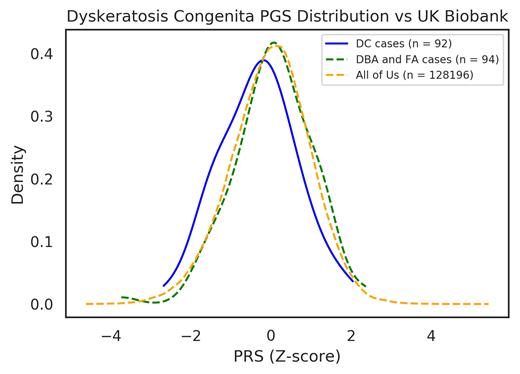Telomere biology disorders (TBDs) are caused by pathogenic germline variants in genes involved in telomere maintenance resulting in very short telomeres for age and high risks of bone marrow failure, certain cancers, as well as pulmonary and liver disease. Interestingly, some pathogenic TBD mutations have variable expressivity and incomplete penetrance, even within families. Variant carriers can present with early manifestations such as the mucocutaneous triad and bone marrow failure or may not manifest until later in life with adult-onset idiopathic pulmonary fibrosis or liver disease, or have no associated clinical phenotype. The underlying causes of this heterogeneity are poorly understood.
We hypothesized that common genetic variants contributing to inter-individual variation in telomere length in the general population may combine with the effects of monogenic TBD-causing variants to underlie variable clinical manifestations in TBDs. To examine this, we developed polygenic scores (PGS) to predict telomere length using genome-wide SNPs from the UK Biobank. We then applied the most predictive polygenic score to the out-of-sample All of Us cohort, as well as the National Cancer Institute's longitudinal cohort of individuals with inherited bone marrow failure syndromes, including those with TBDs (ClinicalTrials.gov Identifier: NCT00027274).
If monogenic mutations and polygenic predisposition to short telomeres both contribute to the clinical severity of TBDs and likelihood of early-onset manifestations, the distribution of genetically predicted telomere length in this ascertained cohort would be shifted towards shorter telomeres compared with the population average. Consistent with this, individuals with TBDs enriched for early-onset bone marrow failure phenotypes (n = 92) have a median polygenic score 0.32 standard deviations (SDs) shorter than the UK Biobank (p=0.002), and 0.31 SDs shorter than the external All of Us cohort (p=0.003) ( Figure). Individuals with TBDs also have shorter genetically predicted telomeres compared to individuals with Fanconi anemia (n = 45) and Diamond Blackfan anemia (n = 49) (p=0.008), indicating that this phenomenon is specific to TBDs. We binned the PGS into quintiles and show that the lowest quintile is associated with an odds ratio of TBD of 1.89 [1.19,2.86], while being in the highest quintile is associated with an odds ratio of 0.54 [0.29,1.02]. Interestingly, TBD cases with no identified mutation have a median PGS 0.1 SDs towards shorter telomeres than patients with a known mutation. Collectively, these results indicate that common, genome-wide determinants of telomere length are significant modifiers of the early-onset manifestations of TBDs.
We hypothesized that the converse should also be true: TBD causal variants should be present in adult population cohorts, and adult individuals with a pathogenic variant who avoided the severe childhood-onset manifestations of TBDs, should not have polygenically predicted short telomere length. To test this hypothesis, we filtered the UK Biobank for TBD causal variants annotated in ClinVar, and identified 71 putative pathogenic cases. Importantly, among these cases there were no individuals with bone marrow failure, but these individuals did have shorter telomeres compared with the UK Biobank. Interestingly, these 71 putative cases had a population-normal telomere length PGS, and significantly longer PGS predicted telomere length than the NCI cohort (p=0.025). We also find that being classified as among these pathogenic cases is associated with an odds ratio for developing pulmonary fibrosis of 10.79 [4.34,26.8]. In summary, despite normal PGS and absence of bone marrow failure, these putative cases have short telomeres and increased risk of adult manifestations of TBDs, consistent with the idea that the pathogenic mutations and common genetic variation affecting telomere length combine to impact expressivity.
Collectively, these findings indicate that polygenic effects on telomere length can modify the impacts of monogenic mutations in TBD-associated genes. These results have implications not only for clinical risk assessment in patients with TBDs, but also for our general understanding and interpretation of variable penetrance/expressivity in presumed monogenic disorders.
Disclosures
No relevant conflicts of interest to declare.


